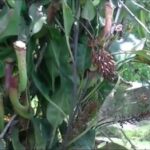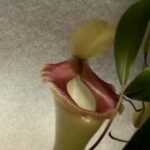As an Amazon Associate, this site earns commissions from qualifying purchases. For more details, click here.
The byproduct of n. rafflesiana and n. ampullaria, nepenthes hookeriana is a lowland species known for its speckled pitchers. This plant is easy to grow particularly in warm climates. If you are a beginner you will have a fun time nurturing this plant because it is beautiful and low maintenance.
Nepenthes hookeriana grows in full or partially filtered light, preferably at 70-85 F / 20-30 C. These pitcher plants require lots of water and at least 50% humidity. It does not go dormant in winter.
Nepenthes Hookeriana Care Sheet
| Soil | 1:1 dried sphagnum moss, perlite |
| Water | Spring, natural or distilled |
| Light | Partial to full light, grows well indoors |
| Food | Small flying and crawling insects, freeze dried worms, fish pellets |
| Temperature | 70-85 F (20-30 C} |
| Humidity | 50-80% |
| Dormancy | Not required |
| Propagation | Stem, leaf cuttings |
Soil
Equal parts perlite and dried sphagnum moss is the most widely used though any low nutrient carnivorous soil mix will work with nepenthes hookeriana.
These plants are usually sold with the soil mix, but it is easy enough to prepare your own. You can try peat moss and perlite and that should be fine too.
N. hookeriana adapts well to different soil mixes as long as there is good drainage and aeration. The typical ratio is 1:1 but others use 2:1 or even 3:1.
If you are preparing n. hookeriana soil for the first time it is a good idea to start with equal parts. You can always try other mix ratios during propagation.
Never put compost or fertilizer in the soil. Nepenthes absorbs nutrients through insects so they do not need enrich soil. Fertilizing it can prove fatal to the plant and they may not be able to recover.
Pot Container
You can grow nepenthes hookeriana in 3-5 inch pots or hanging baskets. Repotting is done every two years. We can also recommend TITE Plant Tray because it provides an ideal setting for these plants.
There is not a lot of maintenance required for potted n. hookeriana. You just have to find a sunny location for it and nature does the rest. This lowland nepenthes adapts well to indoors and outdoors as long as there is enough light.
If you are going to use a hanging basket, take the same approach. Find a sunlit location and see how the plant reacts. If it gets too hot, move the basket to a partially shaded location. You can do the same with nepenthes Miranda and similar pitcher plants.
Water
Nepenthes hookeriana requires a lot of water, preferably rainwater or distilled. Water from the top until the soil is moist. Do not soak the soil too much, just enough to keep it constantly damp. Repeat once the dirt starts drying.
Because this plant needs more water than other species, it is easy to overdo. The safest way to water nepenthes hookeriana soil is to use a moisture checker like the Hemdre Soil Moisture Meter. This device indicates if the soil is dry, moist or too wet so you can avoid mistakes.
The other common error is using tap water. Yes it is always close at hand. But tap water often contains high amounts of harmful minerals. Over time these minerals will accumulate in the soil and damage the roots and leaves.
These plants respond well to overhead watering so the tray method is not usually needed. Other pitcher plants benefit from it but not n. hookeriana.
If the weather is really hot and you find yourself watering repeatedly, the tray method could work. But use only a small amount of water. Observe closely how the plant reacts. Stop immediately if the soil gets soggy. If the plant does well, replenish the water as needed.
Light
Pitcher plants make good houseplants for many reasons, one of which is adaptability. This is true for lowland pitcher plants like these.
Nepenthes hookeriana thrives in full or partial sunlight. Start with full sunlight but if the leaves turn brown and the pitchers dry up, use filtered light.
If the environment is favorable, this plant should have no trouble with full sunlight. They are native to Sumatra, Malaysia, Singapore and Borneo, where it is exposed to heat and light.
This only becomes am issue if the temperature soars higher than the ideal range. In that case these nepenthes plants have to be partially covered. If you grow n. hookeriana indoors with artificial lights, use the same approach. See how it responds to full light and make adjustments if necessary.
Whether you grow nepenthes indoors or outdoors, never place it under complete shade. These plants always need a few hours of light every day.
Temperature
The best temperature range for nepenthes hookeriana is 70-85 F (20-30 C}. The plant tolerates lower temperature at night, but it cannot handle freezing. Do not expose nepenthes hookeriana to 95-100 degree heat for long periods.
These are tropical pitcher plants so naturally they thrive in tropical climates. You can grow n. hookeriana outdoors all year if you are in zone 10 and above.
If your zone goes through warm summers and freezing winters, you can keep lowland nepenthes outdoors in spring and summer. But if it is always cold in your area, better to grow n. hookeriana in a greenhouse or terrarium.
If your plant is indoors you can check the temperature with a thermometer. But even without one you should be able to tell if the plant is too hot too cold.
One more thing: the healthier your nepenthes is, the more resistant it is to heat. If it gets enough water, food, nutrients and the right soil, a bit of heat will not cause any harm.
Humidity
Humidity refers to how much moisture is in the air. The higher the humidity, the wetter it feels. In general, pitcher plants grow better when there is plenty of water vapor in the atmosphere.
Nepenthes hookeriana thrives in 50-80% humidity. Medium to high humidity is going to produce the best results. These pitcher plants can adapt to lower moisture but it will not grow as fast.
Nepenthes must produce nectar and liquids in their pitchers to lure insects. A humid environment makes this process easier. The more nectar and liquids in the pitchers, the more insects they can catch.
You also need to water less often in high humidity, and the longer the soil is damp the better for the plant. Whether you are growing n. hookeriana, n. rafflesiana or another species, high humidity is almost always welcome.
Nutrition and Feeding
Nepenthes hookeriana eats flies, yellow jackets, spiders and other small insects. You do not need to feed if the plant is outdoors. If yours is growing in a terrarium, give it food every 1-2 weeks.
Nepenthes eats live and dead bugs, fish betta pellets and freeze dried bloodworms. You just have to drop a small amount into its pitcher and let the plant digest it.
Only a few pitchers have to be fed. You may also add a few droplets of water into the food to soften them up. This will help the plant with the digestion. Do not worry if the plant takes a long time to eat food; that is normal with nepenthes.
If your pitcher plants receive lots of light, they will probably eat less. This is because the plant is already getting plenty of nourishment in the form of glucose.
Dormancy
Tropical pitcher plants like nepenthes hookeriana do not have dormancy. They grow continuously throughout the year.
To keep it simple, n. hookeriana must always be in the same temperature range. Never expose it to freezing or to excess heat. Never leave nepenthes hookeriana outside during winter.
If you have long and cold winters, keep the plant inside. Use indoor grow lights, a humidifier and heater so the environment is similar to summer conditions. You may not be able to replicate it exactly, which is why its growth may slow.
In these cases it might be better to cultivate n. hookeriana indoors all the time. This way you can keep the plant in the same environment instead of growing outdoors in summer and then moving it indoors for winter.
Since these plants do not have dormancy, you can propagate them anytime. The best way to do it is with leaf cuttings as they grow quickly.

My fascination with carnivorous plants began many, many years ago with Venus Fly Traps. Now I am more than happy to impart what I know with other enthusiasts and those who are curious about meat eating plants.



